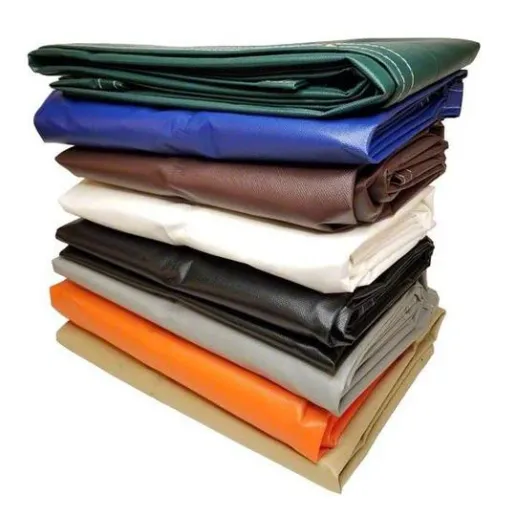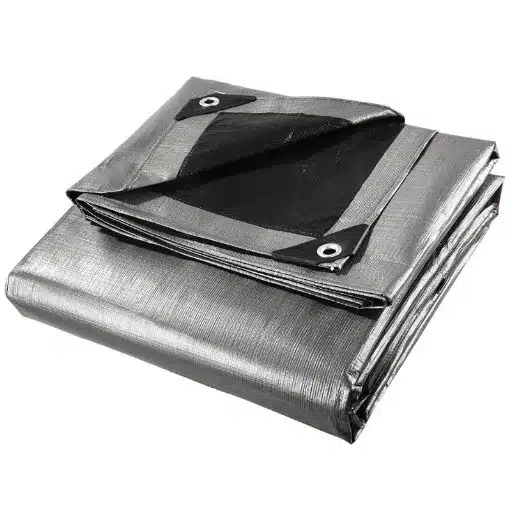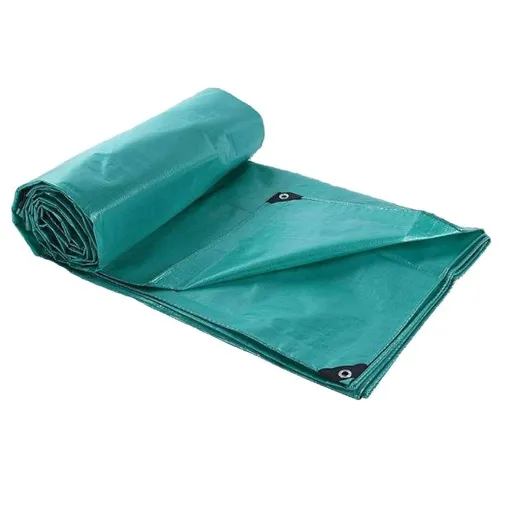Effective camping is all about the simplicity and ease of the use of the camping accessories. The things that are easy to carry are something that you would probably choose. The things you would undoubtedly need is a tarpaulin. These means to simplify your camping minimizes the difference between comfort and the difficulty of the camping. Be it the unpredictable weather, equipment protection, or the enhancement in the camping comfort, tarpaulins serve the purpose like this. With the help of this article, not only the basic but also the helpful camping tarp uses, in the preparation of simplest to comfort camping, can be easily understood. You can completely trust such a simple item can easily become your ultimate campsite helper!
Understanding Heavy-Duty Tarps
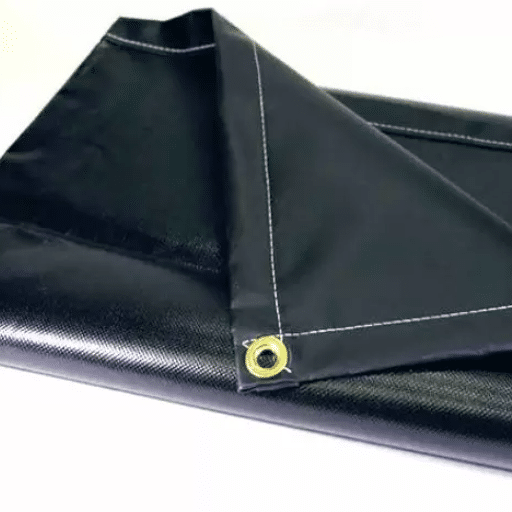
Defining Heavy-Duty Tarps
A tarp is essentially a robust, multi-purpose sheet of fabric made from polyethylene, vinyl, canvas, and other materials. Its primary function is to resist harsh climatic conditions while being used for the protection of any kind of gear, equipment, or tion. They are put to use in any and every possible kind of application, be it households or even offices
Taking the width, thickness, and even the weight into consideration, one of the most appreciated features of a heavy-duty tarp is its versatility. It suits the requirements of many people in various situations. Such heavy-duty tarps can be found in use everywhere. They enable you to customize a solution for nearly every issue you face rather than look into finding special products for every problem.
Heavy-Duty Tarps: Material and Lifespan
Heavy-duty tarps can be made from varying materials, each suited for a particular use or climate. There are the lightweight polyethylene options that is perfect with the lightweight gear, equipment, tools and furniture. On the other hand, airflow considerations makes canvas the best option for using it to protect tools and machinery in the wind. Vinyl tarps are good for transport as it guarantees heavy-duty weather protection.
The strength and resistance to wear and tear is also directly related to the strength of the material of the tarp, referred to as “mil,” and the denier count. As the values of these two metrics increase, the strength and resistance of the tarp also increases. The addition of reinforced edges and the riveted holes, known in the industry as grommets, go a long way in ensuring that the heavy-duty tarps will last even in the most extreme conditions. With basic upkeep, these tarps can epic serve for a great deal of time, establishing the fact that they are versatile, easy to use, and affordable to cater to the large variation of industries and activities needing their use.
Heavy-Duty Tarps: Various Uses
Heavy-duty tarp works in various scenarios like emergency car parking and forklift protecting such name but a few. Additionally, with more people interested in gardening and farming, there is a growing need for protective equipment anything that aids in the farming process and the agricultural as a whole process. The tarp’s increasing popularity alongside farming has also created a trend for covering camping furniture. Outdoor camping, especially with friends and family, is the perfect occasion for such tents. The heavy-duty tarp keeps the furniture and tents safe from exposure to harsh conditions. Such protective gear is in demand in the manufacturing businesses as the protective gear serves multiple purposes; the tarps are heavier than camping tents, which makes them highly durable and washable. Professionally, the heavy-duty tarp is slightly more advanced than the camping tent, which makes its use in camping quite efficient.
Top 3 Uses for Heavy-Duty Tarps on Camping Trips
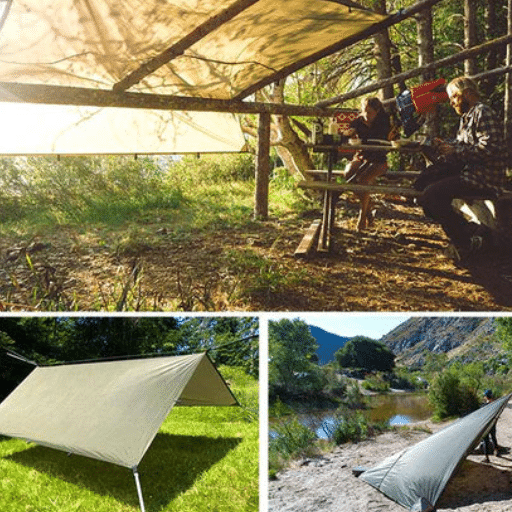
1. Emergencies and Excursions under the Rain Shield of the Sun
During camping trips, heavy-duty tarpaulins are a must-have tool for creating either shade against intense sunshine or an enclosure to protect against heavily pouring rain. By simply fixing a tarpaulin to trees or upright poles, it is possible to build a kiD of partial or temporary protective roof that shields both visitors and materials against the rain and on a bright sunny day, it provides shade. Study of the latest data coming from the Company’s search suggests a subtle growth in the demand for this kind of gear, ‘how to use a tarp for camping shelter’. People born with a love for the outdoors are slowly but surely getting to appreciate the functionality that comes with the use of tarpaulins. Whether it be a simple bit of twine or a more advanced kind with the help of sturdy rope, the use of tarpaulins properly set up can be of great convenience. On the go like camping, their materials hold up well and with the help of different sizes, they have come to be of such great value.
2. Hiking and Sleeping Gears Beneath the Tent and the Tarp
Positioning a tarp beneath the tent whilst sleeping and hiking is the most basic yet the most important habits to secure one’s gears when camping and to add more comfort during the hiking. ‘s search data also shows increment of searches for the question “Should I put a tarp under my tent?” and shows a great need on effective campings. To solve this, a certain tarp, which is the “should-put-tarp-yes tarp”, is very supportive on many outdoor miracles, which include the addition of protective gears. Alongside normal fall camping and even some snuggle camping, using gear is beginning to increase its weight and the gif for ‘lazy’ with the increase of the comprehensive information. This tarp also increases the camping and outdoor comfort by a lot.
3. Equipment for Camping is Facing the Weather: How to Protect
Prior to enjoying your camping adventure, it is important that you check your camping gear in order to protect it from the harsh elements which might be encountered. The weather can be very unpredictable and it is important to keep in mind the effect of rain and how it can affect the camping gear; especially while storing it, and how it affects the hot. With today’s modern use of technology, there is an increasing number of gener ated and recorded experiences which are very important and valuable. Some basics, regardless of the situation, al low for the use of waterproof covers and dry bags which allow the storage of equipment such as backpacks and sleeping bags with an important insulation to, at the very least, a tent or ragfly which can be lifesaving during rain. Recor ding stuff in this manner protects the storage from the sun, which allows it to stop degrading, for example polyester fabrics used.today in most shore tarp devices. A modern edge tarp does this and provides UV pro tection, arresting the dessication and decimation of gear in outdoor applications. Since there is a significant amount of gear needed for outdoor demands, it is vital to store camping gear properly in preparation for the next camping date.
Choosing the Right Tarp for Your Needs
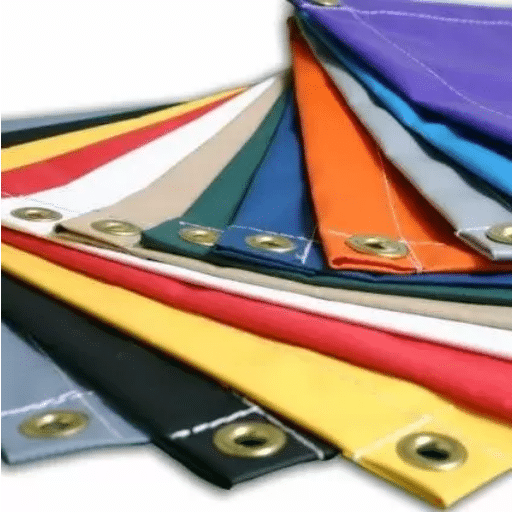
Material and Size Considerations
When selecting a tarp, the material and size are critical elements to be kept in mind. They play a major role in determining the functional and durability of the tarp. Polyethylene, canvas, and vinyl are some of the materials used in making tarps, and each of them has distinct features which makes of the materials suitable for a specific use or need. For instance, Polyethylene is an ideal tarp to use if you are a camper since they are lighter and costs you less money to get one. Canvas is a more excellent option even though it is heavier, to be used in rugged conditions for a more extended time since it offers breathability and premium durability. On the other end, Vinyl offers premium usability for demanding jobs since they have exceptional resistance to ripping and other weather conditions.
Even if you have something you would like to get secured, like a shelter or camping equipment that I have discussed, you need to ensure that the tarp is of an appropriate size. Too small tarps will leave an exposed bit of the gear while the oversized ones are very difficult to secure. When tarping, you need to select a piece that goes for at least two to three feet beyond the area that is in coverage. The balance you choose for the material and dimensions will be crucial, especially in preserving the performance of your tarp over time and in different weather.
The importance of UV resistance and durability
Is the necessity of the tarp fully understood? If the intended use is in rugged or harsh conditions, then the tarp may have to be subjected to prolonged UV exposure. Hence the understanding of UV stability and durability is of paramount importance. A tarp’s durability can be increased by the utilization of new materials designed with specific features to inhibit UV light. The new tarps are UV resistant and therefore do not require extensive maintenance as compared to the canvas options of last year. All of these new products of all the brands protect the canvas material from falling apart and are no longer prone to disintegrating
In recent years, the “eco UV” and “thermal” MRWE tarps have come up and are being lauded for their durability, and the grommet while handling, as well as the diminishing weight to a single metric, is being done. These are the reasons why polyethylene’s durability and UV protection are rated as the best as a polyethylene tarp. When compared to the offering of a polyethylene tarp, vinyl tarps are heavier with a better strength and UV resistance specifically designed for continued and advanced applications. And suppose the application and usage of the material as a tarp is managed and handled according to the described properties and durability rating. In that case, you can ensure product use is maintained.
Right Grommet Placement
Grommet placement is a critical part of tarp use. It is a two-step process, which involves considering the expected load of the tarp and the placement of the grommets. The tarp’s edges should normally have grommets spaced in an even manner to secure fastening and ensure balanced tension upon it. The common practice is to have grommets spread around in a range of 16 inches to 2 feet for general use since it enables adequate fastening while maintaining the tarp’s strength. However, in high-wind conditions or when applying tension in one direction, spacing in the range of 12–18 inches is recommended as it improves stability and minimizes the risks of damage. Consider the shape of the object you are covering in securing, as different shapes may require custom grommet placements to ensure a snug fit. By suiting the grommet to the work that is needed, customers can easily increase the work and life grommet.
Setting Up and Securing Your Heavy-Duty Tarp
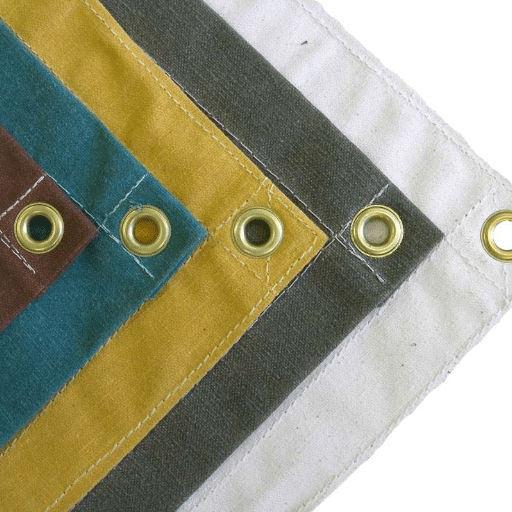
Perfecting the Procedure of Hanging Tarps
When a heavy-duty tarp is hung, it is very important that preparation and methods used are proper. Choose a covering that suits your requirements based on weather resistance, material, and sizing features. Aim to select lying on a patch where additional tools or waste is cleared and is good for grommets that can be reached. Bungees cord, zip ties, or ropes are essential in the even tensing of the material as they prevent sagging and tearing.
Strategic alignment of the ends is also an important concern in the covering due to the effective maintenance of wind exposure resistance to strain on the given points. As a result, the high-quality tarp can be securely fastened with resistances to tearing. The weather should also be checked, because in the presence of high levels of wind or snow, monitor additional devices such as cross-bracing or anchor weights may be necessary to provide extra safeguards. Hence, this will render effective safeguards in situ and in the long run.
Wind Tarp Applications
Important: Stuffing tarps in the windy settings demands the appropriate provisions and safeguards in anticipation of undesired misplacements and destruction. With the recently available information concerning the above prescriptions, it is wise to choose heavy tarps, which are defined as those made from canvas and polyethylene, as these are less likely to have any tears. With other advanced efforts, heavy ropes and ratchet straps, together with bungee cords are indeed a good recommendation, since they maintain a uniform tension of the tarps. Furthermore, sandbags or any other appropriate weigthing is an added advantage to support the tarps in the areas that are vulnerable, particularly during the stronger gushy movements. Moreover, everything taught with a combination will work effectively and in a satisfactory way to the tarps you mount in a storm.
Tarp Life Span Enhancements
The lifespan of your tarp is as long as your care for it. So, maintenance and care are important, especially when cleaning the tarp. The tarp must be cleaned regularly to cleanse the build up of dirt; mould, especially, should not be ignored. The moisture in the tarp is a bit challenging because, once the moisture is in, the best option is to use the tarp, which causes damage to the tarp. Agents like soap and water can be used to wash the tarp, and the drying of the tarp is very important; the moist tarp is not healthy. The storage of the tarp must be safe and very protected from creasing.
Your attention and investment in tarps of good quality is greatly needed. Polyethylene and canvas materials are very durable in terms of care and wear management. These materials in particular require an extra investment; check the areas with stress and in higher areas of the edges. Tarp areas with the thin material placement can be identified and should be identified so as to replace them with more pieces, as this can greatly reduce the grade and marking, and constant exposure to the sun at that location. Always perform extra measures to reduce the marking at that point, so as to reduce the changing of the tarp, which can be very irritating and honestly is not satisfying at all.
Maintenance and Storage Recommendations
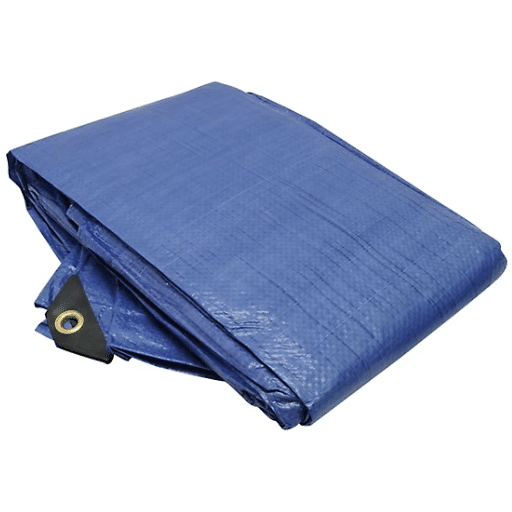
How to Clean and Maintain Your Heavy-Duty Tarp
Heavy-duty tarps deserve proper and regular care to continue serving their purpose. Begin by removing any loose dirt with a soft cloth or brush. For further cleaning, use warm water with mild soap and avoid heavy scrubbing. Always avoid using rough cleaning agents. Remove all traces of soap with a thorough rinse. It is important that the tarp is left mould free, so making sure it’s fully air dried before storing is extremely important.
In terms of storage, do not store the tarp in direct sunlight, as it can weaken the material. Neatly fold the tarp and use an airtight container or hardwearing storage bag to protect it from pests and humidity. If your tarp is used often, repair any minor damages quickly to prevent complete degradation with the help of patches or tarp repair tape. With such simple but consistent care routines, your heavy-duty tarp should serve you well for many years.
How to Properly Store Your Heavy-Duty Tarp
In order to effectively store a heavy-duty tarp, the best control and prevention methods, as well as the aged practices, will provide an above average usability and maintain long term use according to the most recent productivity and search driven advice. One persistent problem for the consumers according to Google’s search data is the prevention of the mildew preservation while in the storage which is caused by uncontrolled humidity. In order to minimize this, the aged advice isto use clean and avoid direct light sources of absorbers is to be used for tarp to be stored with enough space, highly recommended. ‘s tarping, along with other aids such as rolling as opposed to folding to prevent weak crease, blank or sealing, or refining, is highly recommended. Due to the frequency of usage, having an adequate preventive approach to almost all tarp issues provides an easier control, especially for the older covers.
Wise Investment Techniques
In order to protect and manage what you have, following the latest data insights from up-to-date search engines is highly advised. In correlation with the mentioned query known from the most current search engine, a huge number of people are worried about looking after and managing high value and quality material. The most searched query, “how to increase the life of the things purchased,” makes it a top priority for most people. This type of worry is what makes people want to save money, and it’s best solved by implementing the help of prepared protective care. Not only protective care, but it’s also supported by spare parts or care items to maintain the quality of the outdoor gadgets one has. The approaches supported by the most recent data, as informed by the search engine queries, provide evidence to justify the approaches and removes all the doubt that might be there.
FAQ
How are heavy-duty tarps useful for a camping trip?
Heavy-duty tarps are useful for a camping trip in several ways, and they help campers achieve several camp tasks. They can be used as ground covers for our tents, allowing the tent to withstand water and sand after harsh camping. Also, they serving as additional outdoor tents that allow campers to do their other activities. Rain does not always fall, and covering firewood with tarp ensures that it is not soaked anytime water decides to fall. Heavy-duty tarps are also good in recovering melted rainwater in a tank. Heavy-duty tarps are the best option to use for your plans, whether it is for covering your gear or for your temporary residence.
How do I choose the best tarp for my camping needs?
To select a tarp that best meets your camping needs, you should consider the different types available to you which include, canvas tarps, vinyl tarps, and polyethylene tarps. Each of them comes with different improvements and insulation measures, which you need to understand in order to make an excellent decision. An example would be canvas tarps which are specifically waterproof tarps, which enable various waterproof techniques to be installed while also maintaining breathability as a method to avoid condensation. You should learn to identify grommets and look for UV protection to shield the tarp under the head of the sun. As you select the product, also consider the size and weight to ensure it is suited for your camping and, more crucially, the design of the tarp.
Can tarps really be used to protect tents of mine?
Yes, using a tarp is crucial for protecting your tent, especially if you camp often. Having a tent with a layer of insulation is very helpful, as it shields the tent from sharp objects and any moisture in the ground. As a waterproof cover, a tarp can be used to shield a tent from UV rays and rain, which is very helpful. Imagine being secure and having an efficient living space due to your camping equipment being in good condition. They can even be stretched, giving you the chance to find the one that fits the size of your tent best to shield your camping equipment.
What are other uses of tarps in nature?
In addition to camping, tarps offer a range of advantages in the context of outdoor activities. Providing a safe and dry canopy for your outdoor party equipment, a tarp protects your guests and gear against the rain and dew. Rain and sunlight can significantly harm outdoor sofas and other furniture, but a tarp can come in handy for their protection. Made of a durable and waterproof material, tarps can serve as a picnic mat in a park, allowing you to have a clean place to sit. Also, tarps are efficient in the covering of heavy loads and can be used as a temporary barrier for certain construction jobs. As a result, nature lovers and adventure seekers should have a collection of tarps at their disposal.
How do heavy-duty tarps protect against harsh weather?
The durability of heavy-duty tarps can withstand the severe effects of the elements. They are effective against harsh conditions due to the performance of the materials used to make them. Specifically, the fabrics used are either vinyl or heavy canvas, and the thick fabric is able to resist very harsh conditions such as heavy rains and cold wind, while the fabric is designed to be waterproof. Tarps also help with camping equipment by protecting it. In addition, the tarps have a degree of UV protection which is a good feature. And with the investment of some money, owning a good durable tarp has a variety of helpful applications, making them extremely popular.
Reference Sources
- Boston University Blog: Discusses the versatility of tarpaulins, including their use for protection against wind, rain, and UV rays, making them effective for camping and outdoor activities.
- The New School Portfolio: Provides a guide on PVC tarpaulins, highlighting their waterproof and sturdy properties, which make them suitable for camping shelters and emergency use.
- Princeton University Outdoor Action: Offers an equipment list for backpacking trips, emphasizing the importance of protective layers and gear like tarps for outdoor activities.

